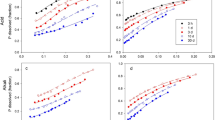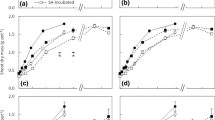Abstract
Laboratory studies have shown that up to 70% reactive rock phosphate dissolves in three soil types found in the high rainfall (> 800 mm annual average) area of south-western Australia. Three field experiments were undertaken on these soils to compare reactive apatite rock phosphate from North Carolina (NCRP) with single superphosphate (SSP) as fertilizers for subterranean clover (Trifolium subterraneum) pasture. Vertical leaching of phosphorus (P) occurs in one soil, a deep, very sandy, acid peaty sand. Lateral leaching of P occurs in the second soil, a shallow (3 cm) sand over a slowly permeable sandy clay loam. No leaching of P occurs in the third soil, a uniform, permeable red sandy loam with a moderate capacity to sorb P. All the soils remained moist to very wet for the 6 to 8 month growing season. Fertilizers were applied once only to different plots over a four-year period (1992 to 1995). Each year fertilizer effectiveness was determined relative to the effectiveness of freshly-applied (current) SSP using yield and P content of dried clover herbage and bicarbonate-soluble P extracted from the soil (soil test P) as indices of effectiveness.
For the two P leaching soils, NCRP was less, equally, or more effective than current SSP in different years. This variation is attributed to the different extents of leaching of P from current SSP in different years which experienced different amounts of rainfall and associated leaching. For the non-P leaching soil, the effectiveness of current NCRP and the residual effectiveness of NCRP were from 5 to 80% the values for current SSP. When measured using soil test P, current NCRP and residual NCRP varied from 40% as effective, to equally or 30% more effective as current SSP at one site, but were about 20% as effective at the other two sites. For the two P leaching soils in some years, the residual value of RP was higher than that of current SSP, presumably due to the rapid leaching of water-soluble P from the SSP. As measured using yield, P content and soil test P, the relative effectiveness of SSP consistently decreased with increasing time from application; the decreases were much less obvious for NCRP.
Similar content being viewed by others
References
Allen DG & Jeffery RC (1990) Methods of analysis of phosphorus in Western Australian soils. Report of Investigation No 37. Chemistry Centre of Western Australia, East Perth
Alston AM & Chin KW (1974) Rock phosphate and superphosphate as sources of phosphorus for subterranean clover on an acid sandy soil. Aust J Exp Agric Anim Husb 14: 358–361
AOAC (1975) Official Methods of Analysis. 12 edn. Assoc. Offic. Agric. Chem., Washington DC
Barrow NJ & Campbell NA (1972) Methods of measuring residual value of fertilizers. Aust J Exp Agric Anim Husb 12: 501–510
Barnhisel R & Bertsch PM (1982) Aluminium. In: AL Page (ed) Methods of Soil Analysis, Part 2. pp 275–300. Am Soc Agron Mono 9, Madison, Wisconsin, USA
Bolland MDA (1996) Effectiveness of Ecophos compared with single and coastal superphosphates. Fert Res 45: 37–49
Bolland MDA & Bowden JW (1986) Summary of long–term rock phosphate experiments in south–western Australia. J Aust Instit Agric Sci 52: 227–236
Bolland MDA & Gilkes RJ (1990) Rock phosphates are not effective fertilizers in Western Australian soils: a review of one hundred years of research. Fert Res 22: 79–95
Bolland MDA, Baker MJ & Lunt RJ (1987) Effectiveness of superphosphate and crandallite–millisite rock phosphate on a deep, very sandy soil as assessed by plant growth and soil extractable phosphate. Aust J Exp Agric Anim Husb 27: 647–656
Bolland MDA, Clarke MF & Boetel FC (1995a) Comparison of single and coastal superphosphate for subterranean clover on phosphorus leaching soils. Fert Res 40: 49–61
Bolland MDA, Clarke MF & Yeates JS (1995b) Effectiveness of rock phosphate, coastal superphosphate and single superphosphate for pasture on deep sandy soils. Fert Res 41: 129–143
Bolland MDA, Gilkes RJ & Allen DG (1988) The residual value of superphosphate and rock phosphates for lateritic soils and its evaluation using three soil phosphate tests. Fert Res 15: 253–280
Bolland MDA, Yeates JS & Clarke MF (1996) Effect of fertilizer type, sampling depth, and years on Colwell soil test phosphorus for phosphorus leaching soils. Fert Res 44: 177–188
Colwell JD (1963) The estimation of the phosphorus fertilizer requirement of wheat in southern New South Wales by soil analysis. Aust J Exp Agric Anim Husb 3: 190–197
Earle DF & McGowan AA (1979) Evaluation and calibration of an automated rising plate meter for estimating dry matter yield of pasture. Aust J Exp Agric Anim Husb 19: 337–343
Fitzpatrick EN (1961) Rock phosphate as a fertilizer. J Agric West Aust 2 (4th series): 459–460
Gilkes RJ& Hughes JC (1994) Sodium fluoride pH of south–western Australian soils as an indicator of P sorption. Aust J Soil Res 32: 755–766
Gillman GP (1973) Studies on some deep sandy soils in Cape York Peninsula, North Queensland. 3. Losses of applied phosphorus and sulphur. Aust J Exp Agric Anim Husb 13: 418–422
Hammond LL, Chien SH & Easterwood GW (1986) Agronomic effectiveness of Bayovar phosphate rock in soil with induced phosphorus retention. Soil Sci Soc Am J 50: 1601–1606
Hingston FJ (1959) The loss of applied phosphorus and sulphur from soils under pasture in Western Australia. J Aust Instit Agric Sci 25: 209–213
Hughes JC & Gilkes RJ (1984) The effect of chemical extractant on the estimation of rock phosphate dissolution. Aust J Soil Res 22: 475–481
Hughes JC & Gilkes RJ (1986) The effect of rock phosphate properties on the extent of fertilizer dissolution in soils. Aust J Soil Res 24: 209–127
Hughes JC & Gilkes RJ (1994) Rock phosphate dissolution and bicarbonate–soluble P in some soils from south–western Australia. Aust J Soil Res 32: 767–779
Kanabo IAK & Gilkes RJ (1987) The influence of the addition of goethite to soil on the dissolution of North Carolina phosphate rock. Aust J Soil Res 25: 313–322
Kanabo IAK & Gilkes RJ (1988) The effects of moisture regime and incubation period on the dissolution of North Carolina phosphate rock in soil. Aust J Soil Res 26: 153–163
Khasawneh FE & Doll EC (1978) The use of phosphate rock for direct application to soils. Ad Agron 30: 115–124
Lewis DC, Clarke AL & Hall WB (1981) Factors affecting the retention of phosphorus applied as superphosphate to the sandy soils in south–eastern South Australia. Aust J Soil Res 19: 167– 174
Loveday J (1974) Methods for analysis of irrigated soils. Commonwealth Bureau of Soils, Tech Comm No. 939
Murphy J & Riley JP (1962) A modified single solution method for the determination of phosphate in natural waters. Anal Chem Acta 27: 31–36
Ozanne PG & Shaw TC (1967) Phosphate sorption by soils as a measure of the phosphate requirements for pasture growth. Aust J Agric Res 18: 601–612
Ozanne PG, Kirton DG & Shaw TC (1961) The loss of phosphorus from sandy soils. Aust J Agric Res 12: 409–413
Paton DF & Loneragan JF (1960) An effect of lime on residual phosphorus in soil. Aust J Agric Res 11: 524–529
Ross GJS (1980) ‘MLP Maximum Likelihood Program’ (Rothamsted Exp Stat: Harpenden, UK)
Silverman SR, Fuyat RK & Weiser JD (1952) Quantitative determination of calcite associated with carbonate bearing apatites. Am Mineralogist 37: 211–222
Smith JP & Lehr JR (1966) An X–ray investigation of carbonate apatites. J Agric Food Chem 14: 342–349
Smyth TJ & Sanchez PA (1982) Phosphate rock dissolution and availability in Cerrado soils as affected by phosphorus sorption capacity. Soil Sci Soc Am J 46: 339–345
Syers JK & MacKay AD (1986) Reactions of Sechura phosphate rock and single superphosphate in soil. Soil Sci Soc Am J 50: 480–485
Walkley A & Black IA (1934) An examination of the Degtjareff method for determining soil organic matter and a proposed modification of the chromic and titration method. Soil Sci 37: 29–38
Weaver DM, Pen LJ & Reed AEG (1994) Modifying the phosphorus cycle to achieve management objectives in the Oyster Harbour catchment. Water J 21: 28–32
Yeates JS, Deeley DM, Clarke MF & Allen D (1984) Modifying fertilizer practices. J Agric West Aust 25 (4th series): 87–91
Yuen SH & Pollard AG (1954) Determination of nitrogen in agricultural materials by the Nessler reagent. II. Micro–determinations in plant tissue and soil extracts. J Sci Food Agric 5: 364–369
Author information
Authors and Affiliations
Rights and permissions
About this article
Cite this article
Bolland, M., Gilkes, R. The relative effectiveness of superphosphate and rock phosphate for soils where vertical and lateral leaching of phosphate occurs. Nutrient Cycling in Agroecosystems 51, 139–153 (1998). https://doi.org/10.1023/A:1009794408746
Issue Date:
DOI: https://doi.org/10.1023/A:1009794408746




